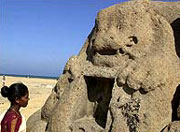 |
|
Experts say a lion
revealed by the tsunami is from the 7th
Century | |
Indian divers have found more evidence of an
ancient port city, apparently revealed by December's tsunami.
Stone structures that are "clearly man-made" were seen on the
seabed off the south coast,
archaeologists say.
They could be part of the mythical city of Mahabalipuram, which legend says was so
beautiful that the gods sent a flood that engulfed six of its seven
temples.
Other relics were revealed when the powerful waves washed away sand as
they smashed into the Tamil Nadu coast.
The Archaeological Survey of India launched the diving expedition after
residents reported seeing a temple and other structures as the sea pulled
back just before the tsunami hit.
The new finds were made close to the 7th Century Mahabalipuram temple,
which some say is the structure that survived the wrath of the gods.
"We've found some stone structures which are clearly man-made,"
expedition leader Alok Tripathi told the reporters.
"They're perfect rectangular blocks, arranged in a clear pattern."
The ancient "gifts" of the tsunami are expected to be presented to an
international seminar on maritime archaeology in Delhi next month.
Other discoveries made at Mahabalipuram earlier this month include a
granite lion of a similar age to the temple that experts believe had been
buried for centuries before the tsunami shifted the sand.
Archaeologists have been working at the site for the last three years,
since another diving expedition discovered what appeared to be a submerged
city, including at least one temple.
The myths of Mahabalipuram were first written down by British traveller
J Goldingham who was told of the "Seven Pagodas" when he visited in 1798.
(BBC) |
去年12月份的海啸掀开了印度一个古代港口城市的面纱,目前印度潜水员们发现了更多实证。
考古学家们表示,在印度南部海岸附近海底发现的石头建筑“明显是人工建造的”。
它们可能是传说中的马哈巴利普兰古城的一部分,神话中说这座城市太美丽了,以至于诸神唤来洪水,淹没了城内七座寺庙中的六座。
当强大的海浪袭击泰米尔纳德邦省的海岸,冲走了海滩上的沙子后,神庙遗迹露出了海面。
就在海啸发生前,有居民报告退潮时看到一座寺庙和其他建筑物,印度考古学调查组随后派出了潜水探察队。
这些新发现位于马哈巴利普兰寺庙附近,马哈巴利普兰寺庙建于公元7世纪,有人说这些建筑侥幸逃过了诸神的惩罚。
“我们发现了一些显然是人工修建的石头结构的建筑物。”探察队领队阿洛克·特里帕蒂对记者说。
“它们是用完美的长方形石块按一定样式搭建而成的。”
海啸带来的这件古代“礼物”将于下个月在印度德里市举行的海上考古学国际研讨会上露面。
二月份早些时候,在马哈巴利普兰还有其他一些发现,包括和这座寺庙年代相仿的一只花岗岩石狮,专家认为在海啸冲走浮沙之前,它已经在海底埋藏了数个世纪了。
在过去的三年中,考古学家们一直在这片遗址工作。在另一次潜水探测中,他们发现了一座沉没水中的城市,里面至少有一座寺庙。
有关马哈巴利普兰的种种传说最早是由英国旅行家戈丁汉姆记载的。1798年他访问印度时,听到了“七座宝塔”的神话传说。
(中国日报网站译) |
